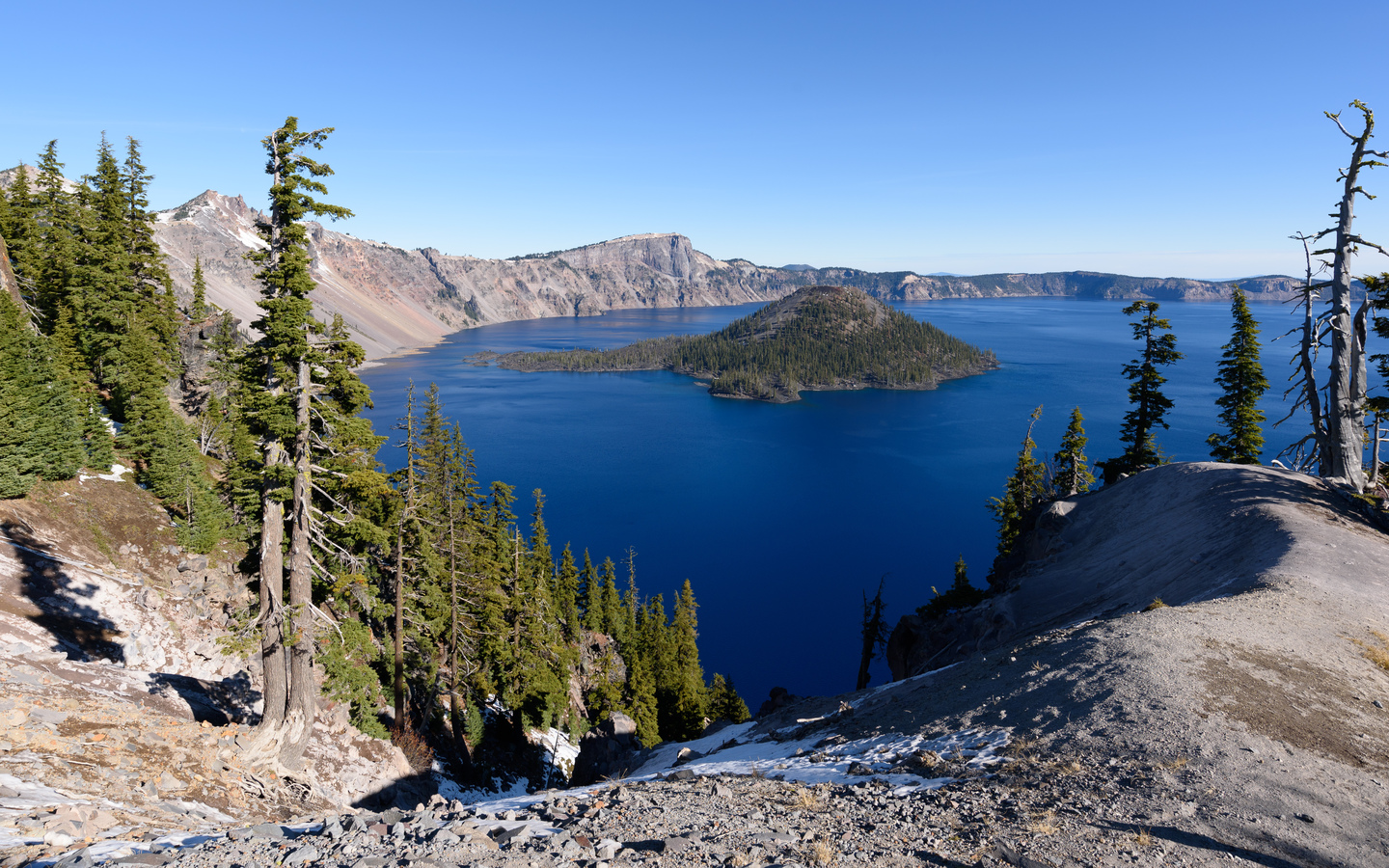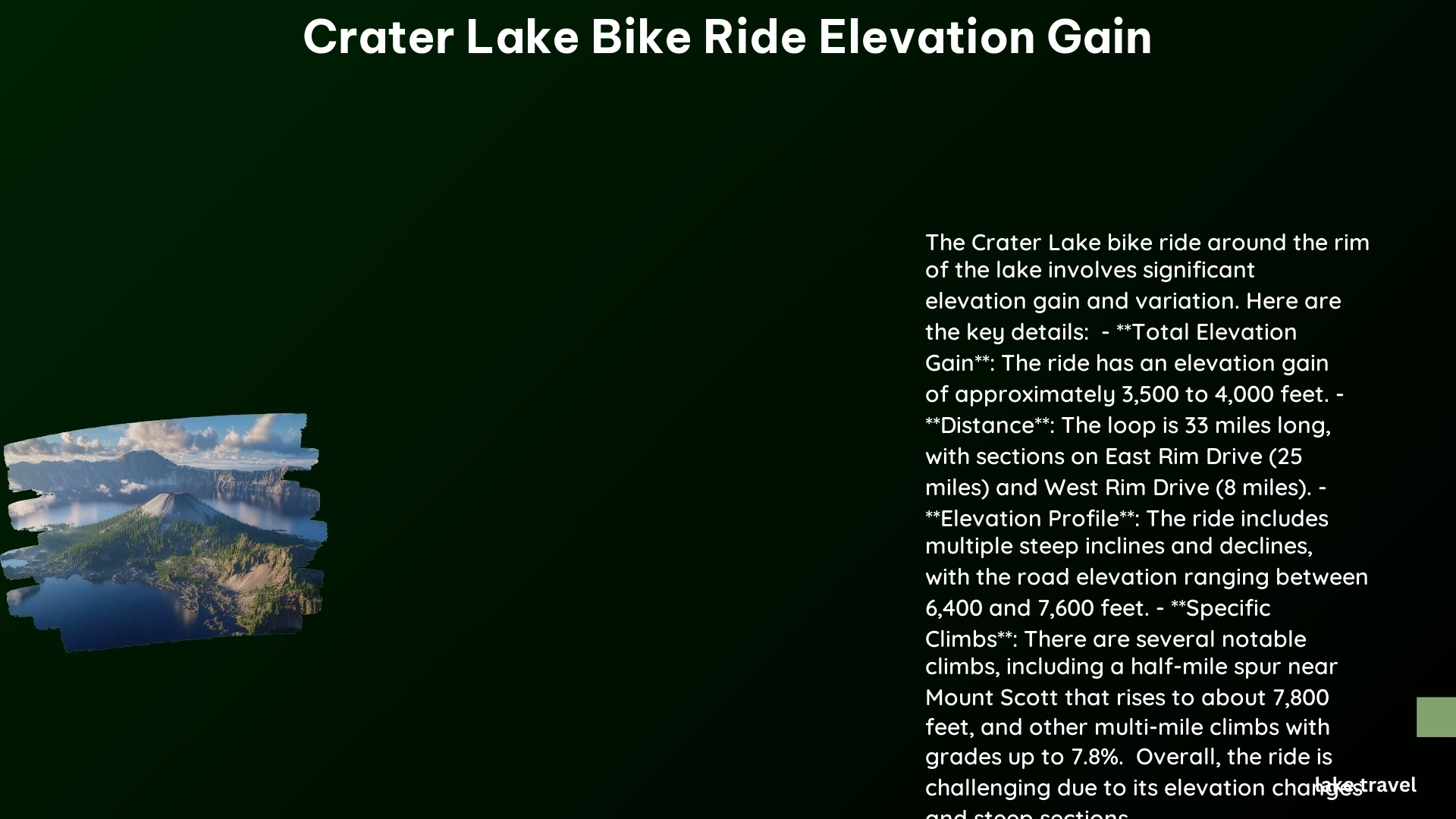The Crater Lake bike ride offers a stunning 33-mile loop with an elevation gain of 3,035 to 4,000 feet. This challenging route circles the rim of Crater Lake, providing breathtaking views and a test of endurance. Cyclists face continuous ups and downs, with grades ranging from 4% to 7%. The ride, set at elevations between 5,000 to 8,000 feet above sea level, is rated intermediate to advanced due to steep inclines and high-altitude conditions.
What Makes the Crater Lake Bike Ride Elevation Gain Unique?

The Crater Lake bike ride elevation gain is a defining feature of this iconic route. Here’s what makes it stand out:
- Continuous rolling terrain
- High-altitude cycling
- Stunning panoramic views
- Vehicle-free sections during events
- Challenging ascents and thrilling descents
The combination of these factors creates an unforgettable experience for cyclists seeking both beauty and challenge.
What Are the Key Elevation Statistics for the Crater Lake Bike Ride?

Understanding the elevation profile is crucial for preparing for this ride. Let’s break down the key statistics:
| Statistic | Measurement |
|---|---|
| Total Distance | 33 miles |
| Total Elevation Gain | 3,035 – 4,000 feet |
| Starting Elevation | ~6,000 feet (at Crater Lake Lodge) |
| Highest Point | ~7,900 feet |
| Average Grade | 4-7% |
These numbers highlight the significant vertical challenge presented by the Crater Lake rim route.
How Does the Elevation Profile Vary Around the Lake?
The elevation profile of the Crater Lake bike ride is far from uniform. Let’s examine the variations:
- East Rim Section:
- Approximately 25 miles long
- Net elevation gain of about 3,500 feet
-
Features narrow switchbacks and significant inclines
-
Southeast Half:
- Generally hillier than the northwest half
-
Includes some of the steepest climbs on the route
-
Northwest Half:
- Relatively less hilly compared to the southeast
-
Still presents challenging ascents and descents
-
Starting Point Variations:
- Crater Lake Lodge start avoids an immediate steep climb
- Other starting points may begin with more intense elevation changes
What Challenges Does the Elevation Gain Present to Cyclists?
The elevation gain of the Crater Lake bike ride poses several challenges:
- Cardiovascular Strain:
- High altitude (5,000-8,000 feet) reduces oxygen availability
-
Continuous climbs test endurance and lung capacity
-
Muscle Fatigue:
- Repeated ascents and descents work different muscle groups
-
Long sustained climbs can lead to lactic acid buildup
-
Temperature Fluctuations:
- Elevation changes can cause significant temperature drops
-
Proper layering becomes crucial for comfort
-
Bike Handling:
- Steep descents require skilled braking and cornering
-
Switchbacks demand precise control and balance
-
Mental Toughness:
- Constant elevation changes can be psychologically demanding
- Views of upcoming climbs may intimidate some riders
How Can Cyclists Prepare for the Crater Lake Bike Ride Elevation Gain?
Preparing for the elevation gain is key to enjoying the Crater Lake bike ride. Here are some tips:
- Training:
- Incorporate hill repeats in your training regimen
- Practice long climbs to build endurance
-
Simulate high-altitude conditions if possible
-
Equipment:
- Choose a bike with appropriate gearing for steep climbs
- Ensure your brakes are in excellent condition for descents
-
Consider using wider tires for better traction
-
Nutrition and Hydration:
- Plan for increased calorie and water needs at high altitude
- Bring energy-dense snacks for sustained climbs
-
Use electrolyte supplements to prevent cramping
-
Pacing:
- Start conservatively to account for altitude effects
- Use a power meter or heart rate monitor to maintain effort
-
Take advantage of rest stops to recover and refuel
-
Acclimatization:
- Arrive a day or two early to adjust to the altitude
- Stay hydrated and get plenty of rest before the ride
What Resources Are Available to Support Cyclists During the Ride?
The Crater Lake bike ride offers several resources to support cyclists tackling the elevation gain:
- Rest Stops:
- Five locations along the East Rim
- Provide water, snacks, and basic bike repair tools
-
Staffed with volunteers for assistance
-
Shuttle Service:
- Available along West Rim Drive
-
Transports people (not bikes) between key locations
-
Parking:
- Available at Steel Visitor Center/Park HQ, North Junction, and Picnic Hill
-
Ride sharing recommended due to limited spaces
-
Safety Measures:
- Helmets required for all cyclists
- Speed limits enforced for safety on descents
- First aid kits available at rest stops
How Does the Elevation Gain Affect the Scenic Experience?
The elevation gain of the Crater Lake bike ride significantly enhances the scenic experience:
- Panoramic Views:
- Higher elevations offer expansive vistas of the lake and surrounding landscape
-
Changing perspectives as you climb and descend
-
Diverse Ecosystems:
- Transition through different vegetation zones with elevation changes
-
Opportunity to observe varied flora and fauna
-
Light and Shadow Play:
- Elevation changes create dynamic lighting conditions throughout the day
-
Dramatic shadows cast by rim features on the lake surface
-
Geological Insights:
- Exposed rock formations reveal the volcanic history of the area
-
Unique vantage points to observe the caldera’s structure
-
Weather Phenomena:
- Experience microclimates and weather changes with elevation
- Potential for above-cloud experiences on higher sections
The elevation gain, while challenging, is integral to the awe-inspiring beauty of the Crater Lake bike ride.
What Are the Best Times to Experience the Crater Lake Bike Ride Elevation Gain?
Timing your Crater Lake bike ride can greatly impact your experience with the elevation gain:
- Summer Months (July-August):
- Warmest temperatures and clearest skies
-
Busiest time with more vehicle traffic
-
Early Fall (September):
- Cooler temperatures ideal for climbing
-
Fewer crowds and potential for fall colors
-
“Ride the Rim” Events:
- Typically held on two Saturdays in September
-
Vehicle-free experience on East Rim Drive
-
Early Morning Starts:
- Cooler temperatures for initial climbs
-
Less traffic and better lighting for photography
-
Weekdays:
- Generally less crowded than weekends
- More peaceful experience on climbs and descents
Consider these factors when planning your ride to make the most of the elevation gain challenge and scenic beauty.
The Crater Lake bike ride elevation gain offers a unique blend of physical challenge and natural beauty. By understanding the elevation profile, preparing adequately, and taking advantage of available resources, cyclists can conquer this iconic route and create lasting memories of an extraordinary adventure.
References:
1. Jay’s Essential Bike Rides – Crater Lake
2. Ride the Rim Oregon – Rider Guide
3. Crater Lake Institute – Bicycling
